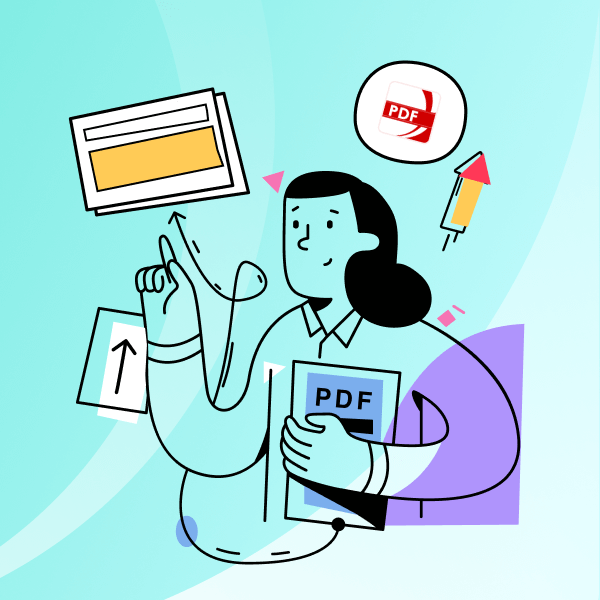Turning web pages into PDFs is invaluable for offline access and information sharing.
Here's a brief, step-by-step guide for both Windows and Mac users.
- How to Save a Website as a PDF for Windows
- How to Save a Website as a PDF for Mac
- How to Save a Website as a PDF: Best Practices
- How to Save a Website as a PDF: FAQ
How to Save a Website as a PDF for Windows
Effortlessly save any webpage as a PDF on Windows with a few simple steps, using the built-in print-to-PDF functionality.

Navigate, edit, and
convert PDFs like a Pro
with PDF Reader Pro
Easily customize PDFs: Edit text, images,
pages, and annotations with ease.
Advanced PDF conversion: Supports
multi-format document processing with OCR.
Seamless workflow on Mac,
Windows, iOS, and Android.
Step 1: Press Ctrl + P to open the print menu

Step 2: Choose “Microsoft Print to PDF” or “Save as PDF” from the printer menu
Step 3: Click ‘Print’ and select your save location

Note for Older Windows Versions: Use Google Chrome’s “Save as PDF” feature if your system lacks Microsoft Print to PDF.
How to Save a Website as a PDF for Mac
Mac users can also easily convert web pages to PDFs using similar steps, taking advantage of macOS's integrated PDF saving options.

Navigate, edit, and
convert PDFs like a Pro
with PDF Reader Pro
Easily customize PDFs: Edit text, images,
pages, and annotations with ease.
Advanced PDF conversion: Supports
multi-format document processing with OCR.
Seamless workflow on Mac,
Windows, iOS, and Android.
Step 1: Press Command + P to open the print menu

Step 2: Select “Save as PDF” from the PDF drop-down menu in the print dialog

Step 3: Click ‘Save’ after choosing your file location
By following these quick steps, saving web content as a PDF is a breeze on both Windows and Mac operating systems.
You can also check our guide on how to save a webpage as a PDF.
How to Save a Website as a PDF: Best Practices
Saving a website as a PDF file is not just about preserving the content; it's about maintaining its integrity for sharing, offline viewing, or documentation.
Here are some best practices to ensure you get the most out of your PDF files.
1. Use the Built-In Browser Tools:
Most modern browsers come equipped with tools to save web pages as PDFs. Typically, you'll find a 'Save as PDF' option in the print menu. Access this feature from the menu bar or by using a shortcut like Ctrl + P or Command + P.
2. Locating the Save Option:
In many browsers, the option to save a web page as a PDF is found in the drop-down menu of the print dialog. Alternatively, look for a share icon, usually located in the top-right corner or the address bar, which often includes a 'Save as PDF' option in the list of options.
3. Selecting the Right Save Location:
When saving a PDF, a pop-up menu will prompt you to choose a save location. Be sure to select a location where the file can be easily accessed for future reference or sharing.
4. Choosing What to Save:
Before saving, ensure that the entire document is set to be saved. Adjust settings in the print menu to include all pages or select specific parts of the website you want to convert.
5. Avoiding Cluttered PDFs:
Some web pages may have ads or irrelevant sidebars. Many browsers allow you to enter a 'reading view' before saving, which can result in cleaner, more professional-looking PDF documents.
6. Checking the PDF Document:
After saving, open the PDF in a PDF viewer to ensure that the conversion went smoothly and that all content is readable and well-formatted.
7. Internet Access and Offline Viewing:
Saving a web page as a PDF is particularly useful when you have intermittent internet access. PDFs ensure that the content is available for offline viewing without needing to reconnect to the internet.
8. Consider Different Conversion Types:
Depending on the content of the web page, consider different conversion types. For instance, if the page includes multimedia elements, a standard PDF might not capture these effectively.
By following these best practices, you can effectively save web pages as PDFs, ensuring they are well-formatted, easily accessible, and ready for any kind of usage, be it for reference, sharing, or offline reading.
For more details, you can also check our feature on the PDF Reader Pro Official Website: Your Best PDF Solution.
How to Save a Website as a PDF: FAQ
Can Any Website Be Saved in PDF Format?
Yes, virtually any website can be saved in PDF format. This function is supported by popular web browsers and doesn't typically require an online tool or additional software.
What Browsers Support Saving Websites as PDFs?
Most modern browsers, including Google Chrome, Firefox, Brave Browser, and other popular desktop browsers, have built-in capabilities to save websites as PDFs. This feature is usually found in the browser menu or print options.
Is it Possible to Save a Website as a PDF on Mobile Browsers?
Yes, many mobile browsers also allow you to save web pages as PDFs. The process may vary slightly from desktop browsers, but the functionality is generally available in the browser menu or print options.
Do I Need a Browser Extension or Separate PDF Tools?
In most cases, you don't need a browser extension or separate PDF tools. Major browsers like Google Chrome and Firefox include a built-in Chrome browser tool that allows you to save web pages as PDFs directly.
How Do I Access the PDF Option in My Browser?
To access the PDF option in your browser, open the browser menu or the print menu. In the print settings, you will often find a PDF option or a 'Save as PDF' choice in the print options or additional options.
Can I Use Any Internet Browser to Save a PDF Through the Browser?
While most modern and popular web browsers support this feature, it's best to use a browser that you are familiar with and that you know has this capability. This includes exciting browser alternatives that prioritize privacy or offer unique features.
Are There Any Limitations When Saving a Website as a PDF?
The main limitation is that dynamic content (like animations or interactive elements) may not be captured accurately in the PDF format. Additionally, the layout may vary slightly from the original web page.
By understanding these key points, you can efficiently use your favorite web browser to save important or interesting websites in PDF format for easy access, sharing, or archival purposes.







 Support Chat
Support Chat